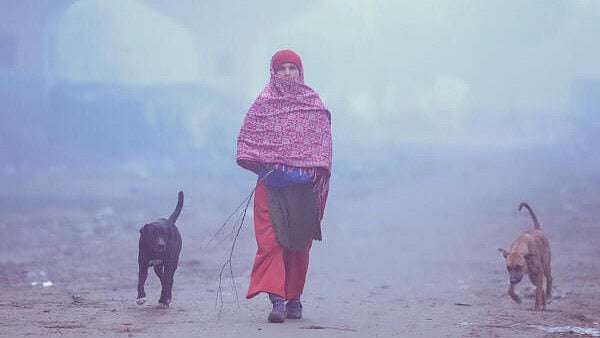
A woman walks on a foggy winter morning, in New Delhi.
Credit: PTI Photo
Globally, pedestrians, bicyclists, and motorised two- and three-wheelers collectively account for 54% of the total number of fatalities in traffic incidents. While advancements in vehicle safety technologies have improved protection for drivers and passengers, Vulnerable Road Users (VRUs) remain highly susceptible to harm in road traffic accidents.
In India, VRUs accounted for over 67% of fatalities in 2023; around 35,000 of them were pedestrians. This high proportion can be attributed to factors such as high motorised vehicle growth, poor road infrastructure, and a lack of dedicated tracks for pedestrians and cyclists. Planning in most cities does not take into account the realities of Indian commuting patterns.
UN Global Road Safety Week, which is observed every alternative year, is scheduled this year from May 12 to 18. It focuses on the theme ‘Streets for Life: Unlocking the multiple benefits of safe walking and cycling’ and calls on policymakers to implement proven interventions.
Among those who travel for work in India, one-third still commute on foot (2011). For commutes up to 10 km, walking is still the most common means of transport. Even in India’s megacities, walking is the most common mode of commuting. In Delhi, an equal proportion of 26% walk and take the bus, while in all other cities, buses come next. In Mumbai, 36% of the population is estimated to walk or cycle to work.
There is a large section of working-class people who use bicycles as the only mode of transportation for their livelihood every day. In Delhi alone, 11% of the working population cycles to work and 36% of households own bicycles (2011 Census). However, there has been a consistent decrease in bicycle ridership over the years in different cities. Cities are increasingly becoming congested – this congestion is marked by a significant rise in the number of vehicles on the roads, increasing safety concerns for walkers and cyclists.
Policy on NMT
The transportation policies in India have been automobile-oriented and have focused on moving vehicles rather than moving people. Road engineering in India is governed by the Indian Roads Congress (IRC) codes that refer to designing footpaths and cycle tracks as Non-Motorised Transport (NMT) infrastructure. However, these codes are not mandatory – they are only advisory and hence are not adhered to for urban road development. As a result, NMT infrastructure in most of the Indian cities is either not built or is left incomplete and the designated space is quickly sacrificed to make way for motorised vehicles.
In 2006, the government issued the National Urban Transport Policy (NUTP) identifying the importance of NMT to access public transport and encouraged cities to integrate NMT facilities with their urban transit projects. However, little was done on the ground, citing difficulties in the implementation of the policy. India’s Transit Oriented Development (TOD) policy (2017) also focuses on pedestrians, cyclists, and other NMT users, recognising the role of
NMT in first- and last-mile connectivity.
There have been several experiments in various Indian cities aimed at improving the walking and cycling experience. In 2014, the Greater Chennai Corporation adopted India’s first NMT Policy aimed at arresting the decline in walking and cycling by creating a safe and pleasant network of footpaths, cycle tracks, greenways, and other NMT facilities. In 2020, Karnataka reported the highest number of pedestrian deaths in the country, accounting for 13% of the total pedestrian fatalities. By issuing a draft, the state initiated the Active Mobility Bill (2021), the first of its kind in India, that seeks to protect pedestrians and cyclists by creating a safe and accessible environment. However, the bill has been a non-starter.
Suraksha 75 Mission (2023) was introduced in Bengaluru to improve 75 critical junctions by improving traffic flow and making the junctions safer for all road users, particularly pedestrians. However, its impact is yet to be seen.
With more than 35,000 km of dedicated cycling lanes, The Netherlands is a global leader in promoting active mobility through cycling. In Copenhagen and in Amsterdam, more than 50% of the total population commutes by bicycle, significantly reducing CO2 emissions, traffic congestion, and improving public health. A recent report (IPCC, 2023), suggests that NMT can reduce emissions from urban transport by 2 to 10%, depending on the context. India needs to do much more in promoting walking and cycling and making them safer, viable alternatives.
(The writer is Director, Centre for Environment and Sustainable Development India)